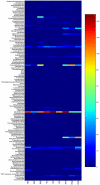Characterization of the fecal microbiome from non-human wild primates reveals species specific microbial communities
- PMID: 21103066
- PMCID: PMC2980488
- DOI: 10.1371/journal.pone.0013963
Characterization of the fecal microbiome from non-human wild primates reveals species specific microbial communities
Abstract
Background: Host-associated microbes comprise an integral part of animal digestive systems and these interactions have a long evolutionary history. It has been hypothesized that the gastrointestinal microbiome of humans and other non-human primates may have played significant roles in host evolution by facilitating a range of dietary adaptations. We have undertaken a comparative sequencing survey of the gastrointestinal microbiomes of several non-human primate species, with the goal of better understanding how these microbiomes relate to the evolution of non-human primate diversity. Here we present a comparative analysis of gastrointestinal microbial communities from three different species of Old World wild monkeys.
Methodology/principal findings: We analyzed fecal samples from three different wild non-human primate species (black-and-white colobus [Colubus guereza], red colobus [Piliocolobus tephrosceles], and red-tailed guenon [Cercopithecus ascanius]). Three samples from each species were subjected to small subunit rRNA tag pyrosequencing. Firmicutes comprised the vast majority of the phyla in each sample. Other phyla represented were Bacterioidetes, Proteobacteria, Spirochaetes, Actinobacteria, Verrucomicrobia, Lentisphaerae, Tenericutes, Planctomycetes, Fibrobacateres, and TM7. Bray-Curtis similarity analysis of these microbiomes indicated that microbial community composition within the same primate species are more similar to each other than to those of different primate species. Comparison of fecal microbiota from non-human primates with microbiota of human stool samples obtained in previous studies revealed that the gut microbiota of these primates are distinct and reflect host phylogeny.
Conclusion/significance: Our analysis provides evidence that the fecal microbiomes of wild primates co-vary with their hosts, and that this is manifested in higher intraspecies similarity among wild primate species, perhaps reflecting species specificity of the microbiome in addition to dietary influences. These results contribute to the limited body of primate microbiome studies and provide a framework for comparative microbiome analysis between human and non-human primates as well as a comparative evolutionary understanding of the human microbiome.
Conflict of interest statement
Figures






Similar articles
-
Fecal microbiomes of non-human primates in Western Uganda reveal species-specific communities largely resistant to habitat perturbation.Am J Primatol. 2014 Apr;76(4):347-54. doi: 10.1002/ajp.22238. Epub 2013 Nov 27. Am J Primatol. 2014. PMID: 24285224 Free PMC article.
-
Plasticity in the Human Gut Microbiome Defies Evolutionary Constraints.mSphere. 2019 Jul 31;4(4):e00271-19. doi: 10.1128/mSphere.00271-19. mSphere. 2019. PMID: 31366708 Free PMC article.
-
Large Comparative Analyses of Primate Body Site Microbiomes Indicate that the Oral Microbiome Is Unique among All Body Sites and Conserved among Nonhuman Primates.Microbiol Spectr. 2022 Jun 29;10(3):e0164321. doi: 10.1128/spectrum.01643-21. Epub 2022 May 19. Microbiol Spectr. 2022. PMID: 35587638 Free PMC article.
-
Worlds within worlds: evolution of the vertebrate gut microbiota.Nat Rev Microbiol. 2008 Oct;6(10):776-88. doi: 10.1038/nrmicro1978. Nat Rev Microbiol. 2008. PMID: 18794915 Free PMC article. Review.
-
The gut microbiome of nonhuman primates: Lessons in ecology and evolution.Am J Primatol. 2018 Jun;80(6):e22867. doi: 10.1002/ajp.22867. Epub 2018 Jun 4. Am J Primatol. 2018. PMID: 29862519 Review.
Cited by
-
Comparative analysis of the fecal bacterial community of five harbor seals (Phoca vitulina).Microbiologyopen. 2016 Oct;5(5):782-792. doi: 10.1002/mbo3.369. Epub 2016 May 14. Microbiologyopen. 2016. PMID: 27734626 Free PMC article.
-
Sulfur metabolizing microbes dominate microbial communities in Andesite-hosted shallow-sea hydrothermal systems.PLoS One. 2012;7(9):e44593. doi: 10.1371/journal.pone.0044593. Epub 2012 Sep 7. PLoS One. 2012. PMID: 22970260 Free PMC article.
-
Microbial genomes from non-human primate gut metagenomes expand the primate-associated bacterial tree of life with over 1000 novel species.Genome Biol. 2019 Dec 28;20(1):299. doi: 10.1186/s13059-019-1923-9. Genome Biol. 2019. PMID: 31883524 Free PMC article.
-
Diet Versus Phylogeny: a Comparison of Gut Microbiota in Captive Colobine Monkey Species.Microb Ecol. 2018 Feb;75(2):515-527. doi: 10.1007/s00248-017-1041-8. Epub 2017 Jul 22. Microb Ecol. 2018. PMID: 28735426
-
Age-Based Variations in the Gut Microbiome of the Shennongjia (Hubei) Golden Snub-Nosed Monkey (Rhinopithecus roxellana hubeiensis).Biomed Res Int. 2021 Mar 12;2021:6667715. doi: 10.1155/2021/6667715. eCollection 2021. Biomed Res Int. 2021. PMID: 33778078 Free PMC article.
References
-
- Dale C, Moran NA. Molecular interactions between bacterial symbionts and their hosts. Cell. 2006;126:453–65. - PubMed
-
- Hickman C. How bacteria contributed to the evolution of multicellular animals? In: McFall Ngai MargaretJ., editor. The Influence of Cooperative Bacteria on Animal Host Biology. New York: Cambridge University Press; 2005. pp. 3–35.
-
- Hooper LV, Gordon JI. Commensal host-bacterial relationships in the gut. Science. 2001;292:1115–8. - PubMed
-
- Fleagle JG. London: Academic Press; 1999. Primate Adaptation and Evolution.291 2nd Edition.
Publication types
MeSH terms
Substances
LinkOut - more resources
Full Text Sources
Other Literature Sources
Medical

